| Table of Contents | 1. Overview 2. Performance Indices 3. Comparison by Performance Indices ……. 3-1. Elasticity Indices ……. 3-2. Vibration Indices 4. Summary |
Yinhe (= Milky Way) is one of China’s leading table tennis companies, and offers a wide variety of blades with high cost performance. Among the various blades made by Yinhe, there are some models similar to famous blades from other companies. However, Yinhe also offers many unique models of its own, and ‘Mars’ series released in 2017 is the important example. ‘Mars’ series is also called as ‘PLC’ series because its artificial material is Polyethylene Carbon (= PLC), and it consists of four models. TTGearLab will analyze these four models through Performance Indices and then compare with some other models in the market.
1. Overview
‘PLC’ means Polyethylene Carbon. The composite fiber that can reduce the stiff feeling of carbon fiber has been widely used since Butterfly announced ‘Arylate Carbon’. The materials those have been mainly used in combination with carbon fiber are Arylate fiber, Aramind fiber, Texalium, glass fiber and PBO fiber (= Zylon). And, polyethylene fiber started to be used at the same time with the release of Yinhe ‘Mars’ series.
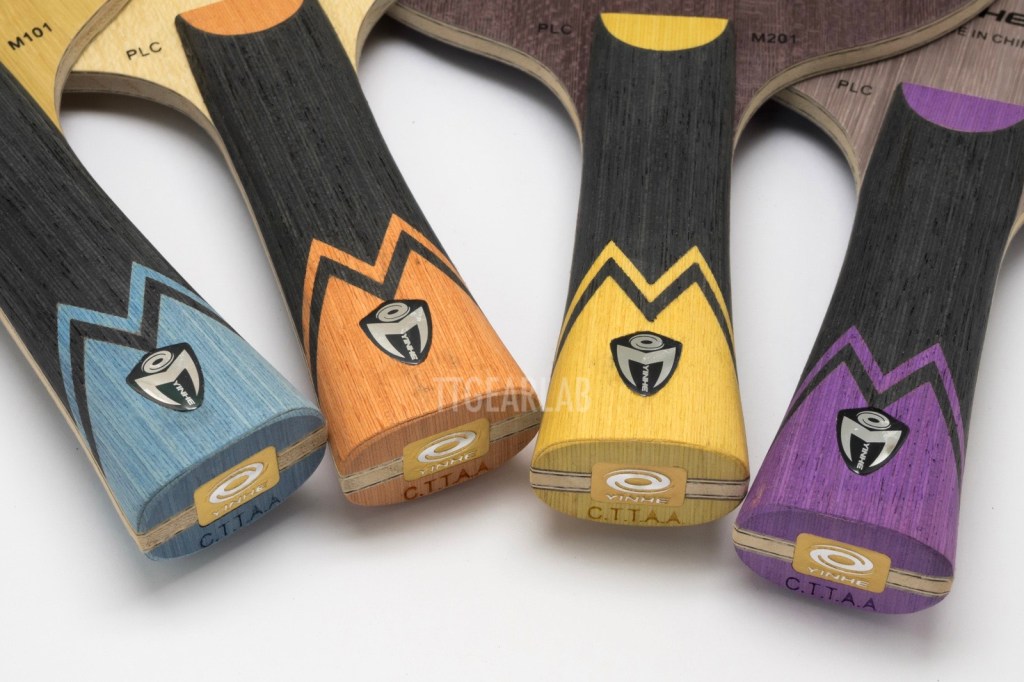
‘Mars’ series includes four models – two outer-PLC models and two inner-PLC models.
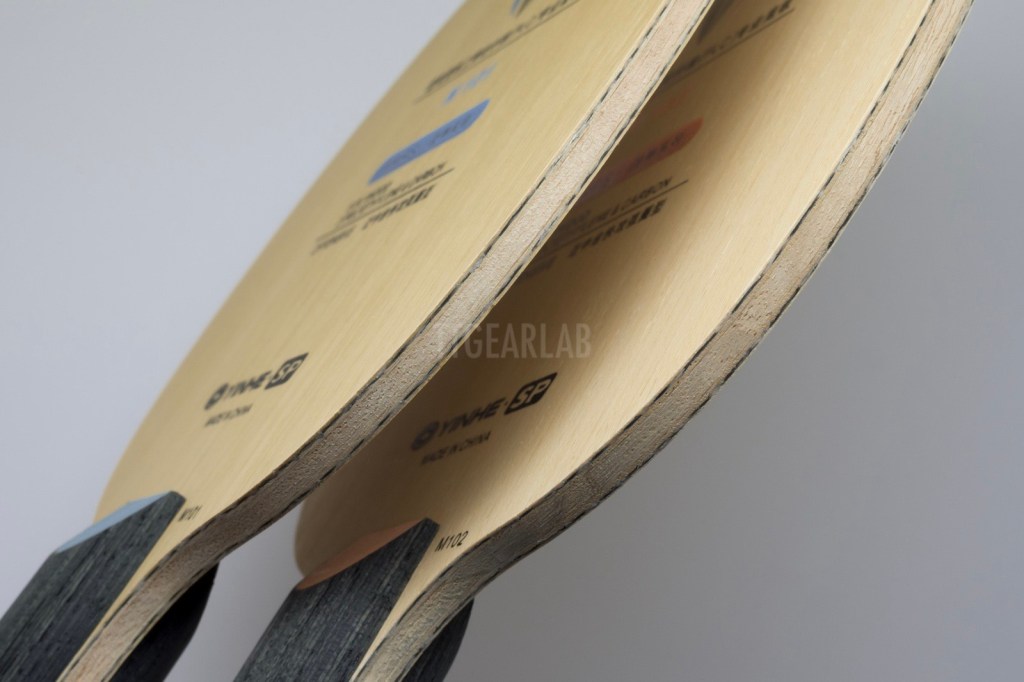
‘M101’ (= ‘Mars 101’) and ‘M102’ (= ‘Mars 102’) are the outer fiber blades in ‘Mars’ series. ‘M101’ is the outer PLC blade of standard elasticity level, and ‘M102’ is the high power version of outer PLC blade.
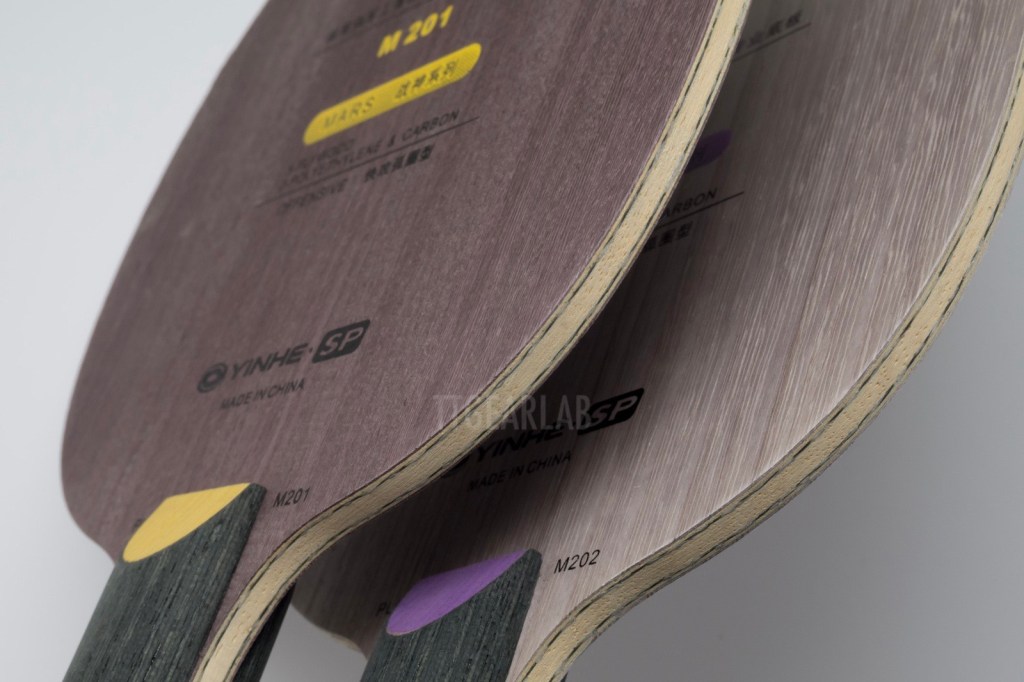
‘M201’ (= ‘Mars 201’) and ‘M202’ (= ‘Mars 202’) are the inner fiber blades in ‘Mars’ series. ‘M201’ is the inner PLC blade of standard elasticity level, and ‘M202’ is the high power version of inner PLC blade.
In other words, the first digit is the distinction between the outer fiber (= 10X) and the inner fiber (= 20X), and the third digit is the distinction between the standard elasticity version (= X01) and the high power version (= X02).
The appearance and composition of each model are as follows:
1-1. M101 (Outer Fiber / Standard type)
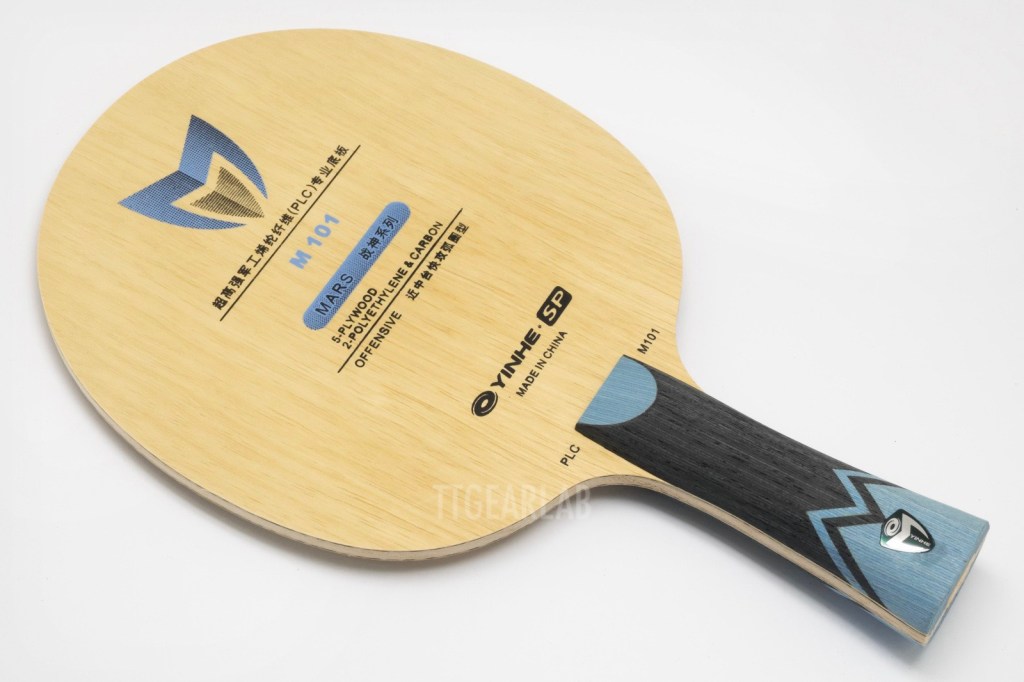
‘M101’ is the outer fiber model of standard type (with standard level of elasticity), and it representative model of ‘Mars’ series. It adopts outer-fiber construction to fully utilize the characteristics of PLC.
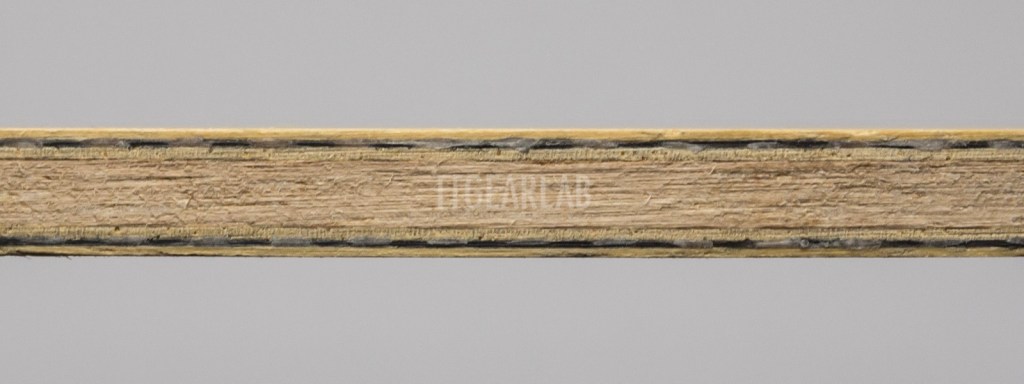
Above picture shows the construction of ‘M101’. The top layer is Limba, and PLC is inserted directly under the top layer. The middle layer is Ayous, and the center layer is Kiri. Overall thickness is around 5.8mm.
1-2. M102 (Outer Fiber / High Power type)
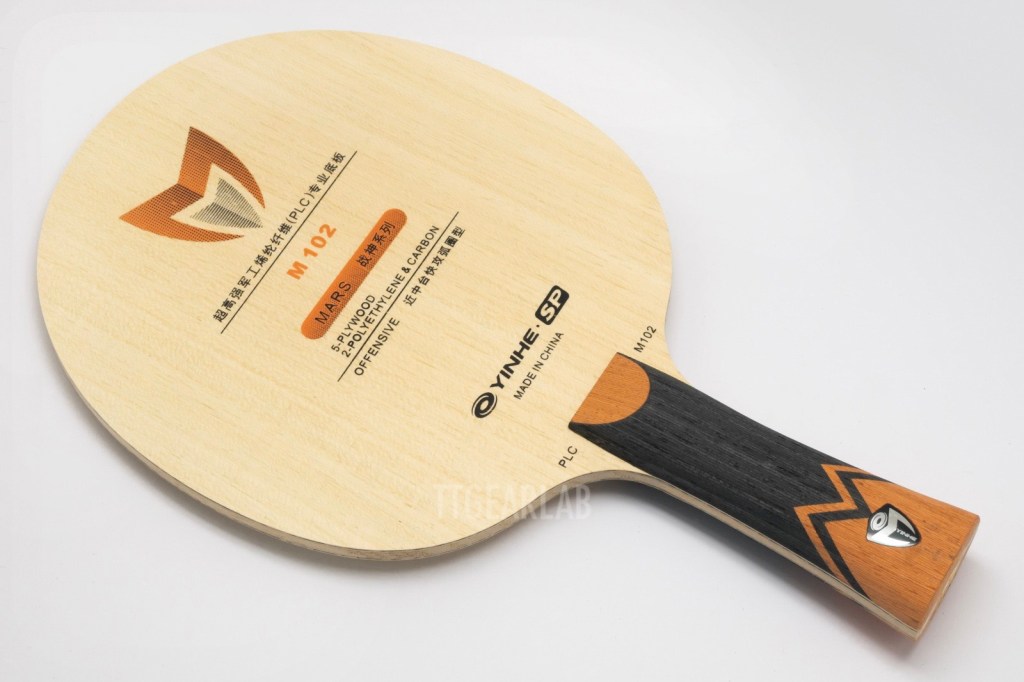
‘M102’ is the outer-fiber model of high-power type. It is thicker and faster than ‘M101’.
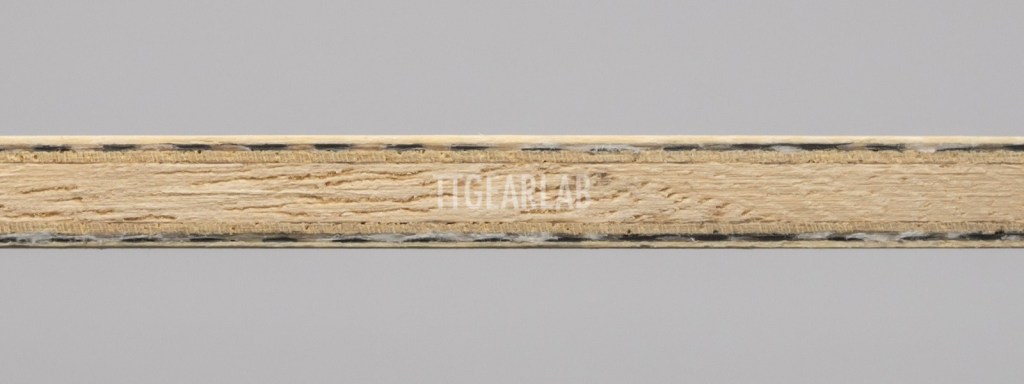
Above picture shows the construction of ‘M102’. The top layer is Koto which is harder than the Limba top layer of ‘M101’. PLC is inserted directly under the top layer. The middle layer is Ayous, and the center layer is Kiri. Overall thickness is around 6.0mm.
1-3. M201 (Inner Fiber / Standard type)
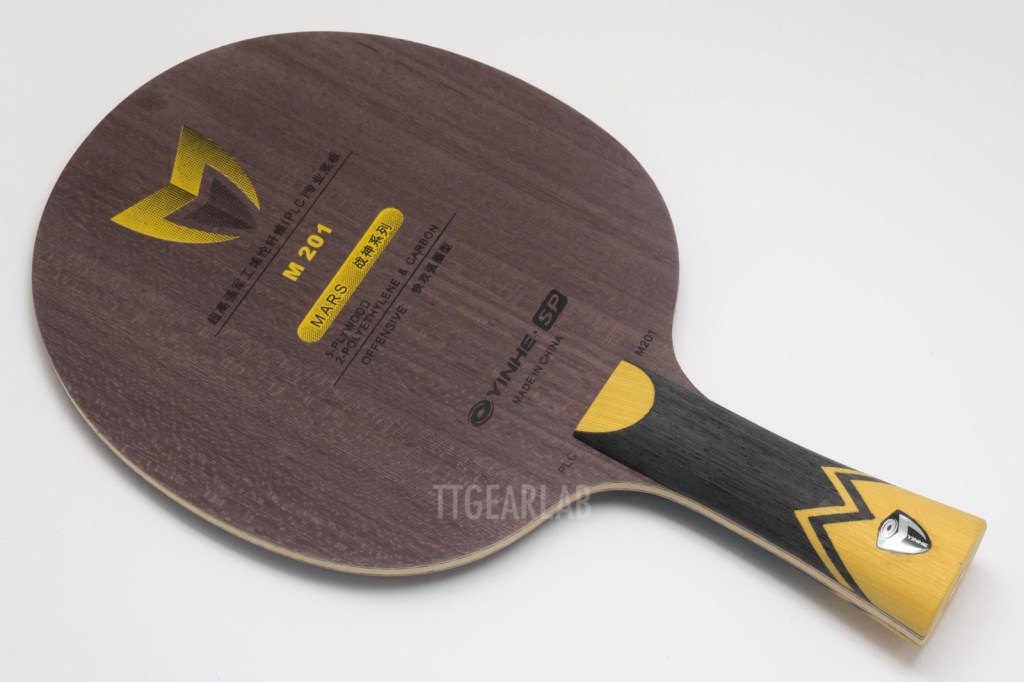
‘M201’ is the standard inner-fiber model of ‘Mars’ series. To reduce the artificial feeling of fiber, PLC is inserted under the middle layer.
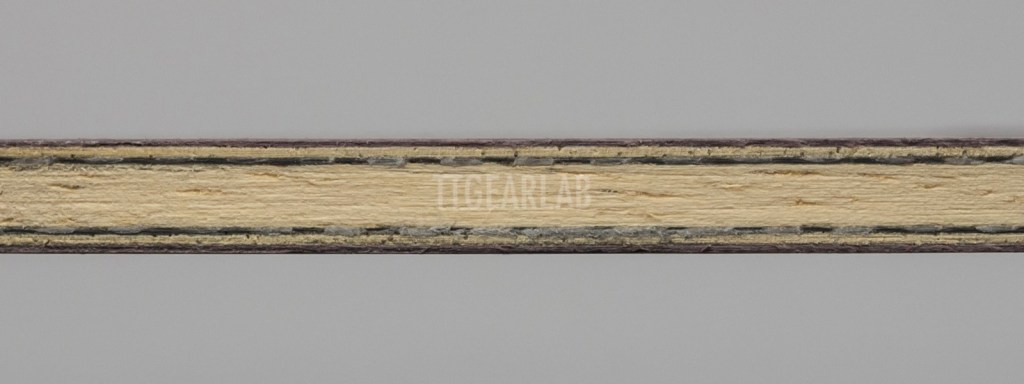
Above picture shows the construction of ‘M201’. Differently from many inner-fiber blades of standard type from other companies, the top layer is dyed Koto. So it is expected that this model aims at more aggressive play at close-to-table area when compared to the standard inner-fiber models with Limba top layer. The middle layer and the center layer are Ayous. Overall thickness is around 5.8mm.
1-4. M202 (Inner Fiber / High Power type)
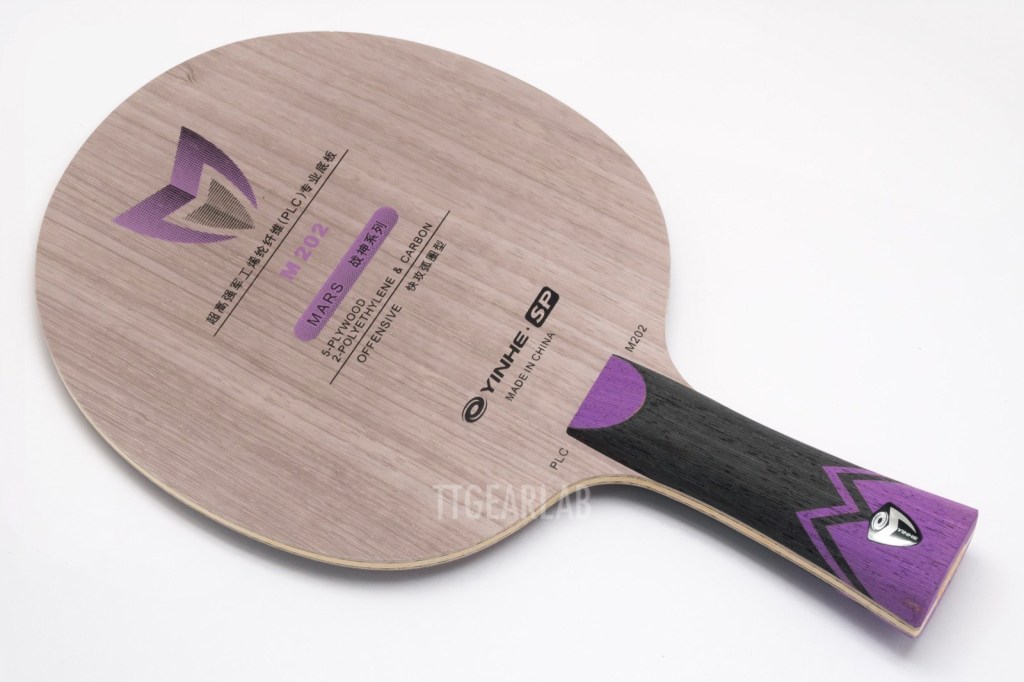
‘M202’ is the inner-fiber of high-power type. It is thicker and faster than ‘M102’.
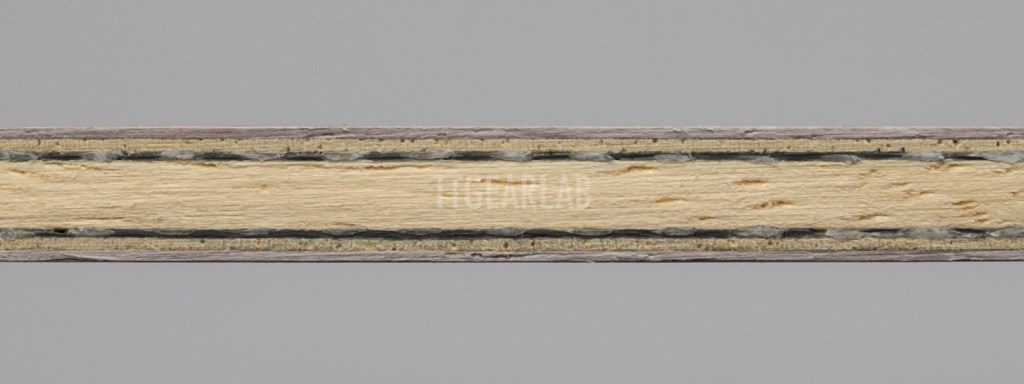
Above picture shows the construction of ‘M202’. Its top layer is dyed Limba, differently from Koto top layer of ‘M102’. So it is expected that this model aims at the playing style with topspin from various distance. The middle layer and the center layer are Ayous. Overall thickness is around 6.1mm.
For ‘M101’, ‘M102’ and ‘M202’, the width of FL (flared) handle is around 25.5mm (at top) ~ 27mm (at bulge) ~ 26 mm (at narrowes point) ~ 35.5mm (at the end), and the thickness of FL handle is around 24mm (at thumb) ~ 25mm (at the end). And, the size of ST (straight) handle which isn’t shown in picture is around 28.5mm (width) x 23mm (thickness). The handles of ‘M201’ are a bit slimmer than above values.
The size of head is around 157mm x 150mm. But, please note that there is difference by piece.
Then let’s check the characteristics of ‘Mars’ series by Performance Indices and then compare with some existing blades.
Please click here to return to top (table of contents)
2. Performance Indices
Performance Indices are measured objective values to represent the characteristics of table tennis gears. Concerning the detail of four performance indices, please refer to following articles in ‘About TTGearLab’ section :
- Performance indices : the way to evaluate blade by measurement
- The example of comparison by performance indices
The performance indices of four models of ‘Mars’ series are as follows. Please note that the values are average values, and can be updated at any time by further measurement.
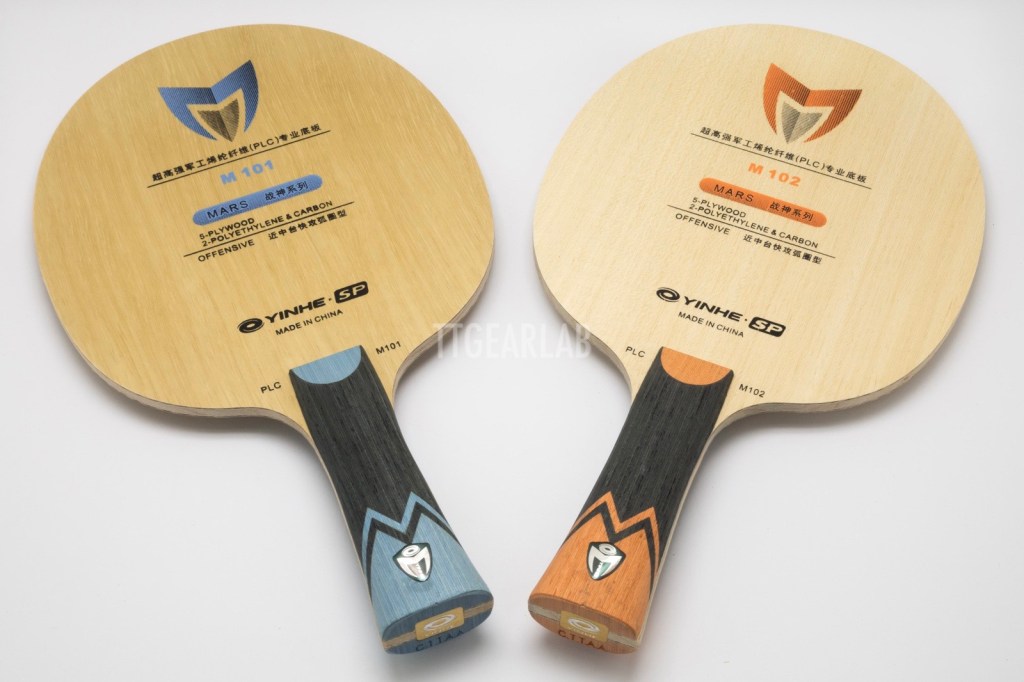
Yinhe M101 (average weight = 85.2g) – outer / STD
Ep = 2.04
Ec = 1.76 (Ec/Ep = 0.86)
Vp = 1.29
Vl = 1.49 (Vl/Vp = 1.11)
Yinhe M102 (average weight = 89.6g) – outer / HIGH POWER
Ep = 2.50
Ec = 1.88 (Ec/Ep = 0.75)
Vp = 1.29
Vl = 1.51 (Vl/Vp = 1.17)
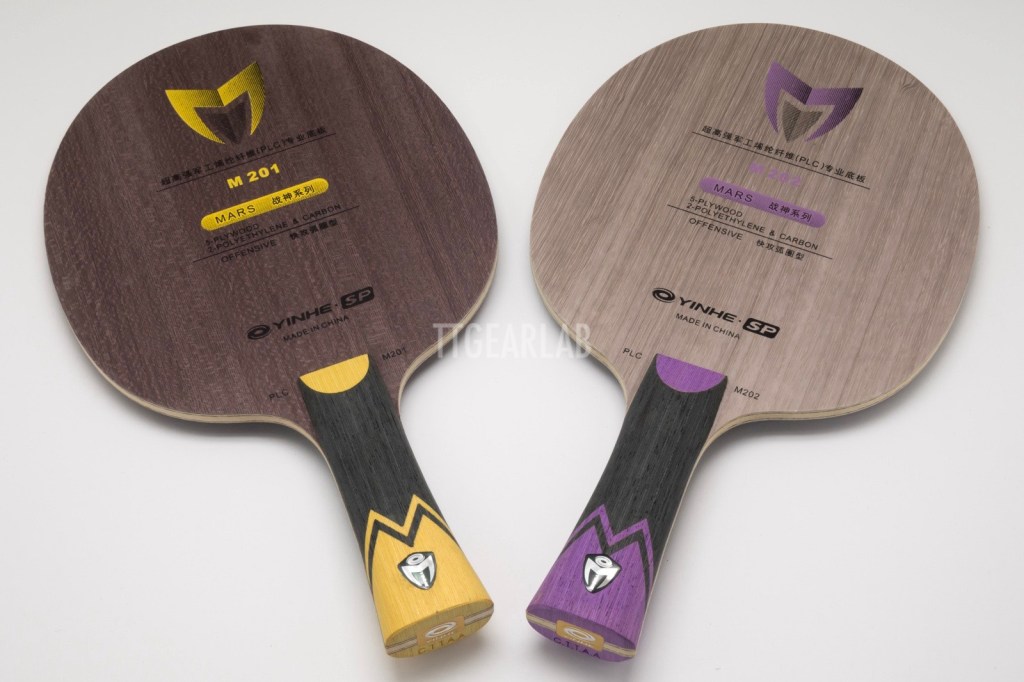
Yinhe M201 (average weight = 87.6g) – inner / STD
Ep = 1.76
Ec = 1.46 (Ec/Ep = 0.83)
Vp = 1.16
Vl = 1.33 (Vl/Vp = 1.15)
Yinhe M202 (average weight = 91.3g) – inner / HIGH POWER
Ep = 2.15
Ec = 1.85 (Ec/Ep = 0.86)
Vp = 1.27
Vl = 1.33 (Vl/Vp = 1.05)
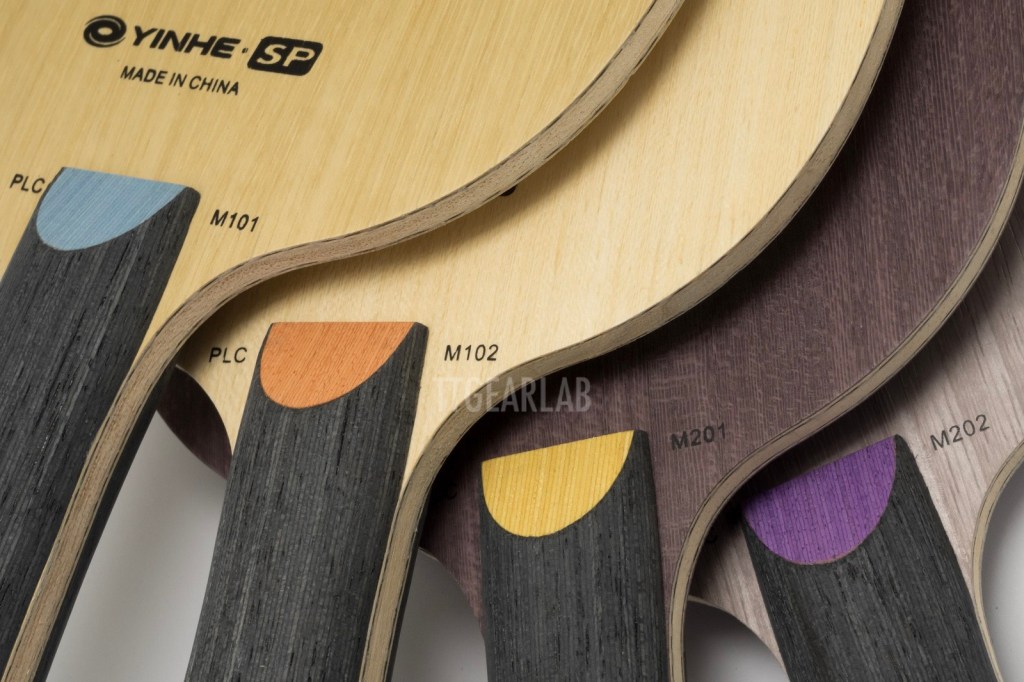
‘M101’ which is the standard outer fiber model shows high level of primary Elasticity Index (= Ep) that we can expect from standard outer-fiber blades. And, its Ec/Ep is under 0.9. It means that it holds the ball deep when the player hits the ball very strongly. The primary Vibration Index (= Vp) is close to 1.30. It is also the value we can expect from standard outer-fiber blades. Its Vl/Vp is over 1.10. So the feeling transferred to index finger is sharper than the primary feeling that is transferred to palm.
‘M102’ which is the outer fiber model of high-power type shows top level of primary Elasticity Index as and outer-fiber blade. We can expect that ‘M102’ is much faster than ‘M101’. And because its central Elasticity Index isn’t that high, its Ec/Ep is very low. It will hold the ball very deep when the player hits the ball very strongly. The Vibration Indices of ‘M102’ aren’t much different from those of ‘M101’, and even the Vp of two models are identical. So, ‘M102’ is much softer than expected from its high elasticity. Its Vl/Vp is also over 1.0, and therefore the feeling transferred to index finger is sharper than the primary feeling that is transferred to palm.
‘M201’ which is the standard inner fiber model shows the moderate level of primary Elasticity Index that we can expect from standard inner-fiber blades. But, its central Elasticity Index looks somewhat low. So its Ec/Ep is under 0.9, and therefore it holds the ball deep when the player hits the ball very strongly. Moderate primary elasticity and ‘Deep Hold’ character fits for aggressive topspin at close-to-table area. The primary Vibration Index is very low, and it means that the feeling of ‘M201’ is soft. It is the softest model in ‘Mars’ series. But, because the lateral Vibration Index isn’t low, its Vl/Vp is very high (= over 1.10). Therefore the feeling transferred to index finger is sharper than the primary feeling that is transferred to palm.
‘M202’ which is the inner fiber model of high-power type shows the Elasticty Indices those are even higher than those of standard outer fiber blades. So ‘M202’ is noticeably faster than ‘M201’. Its Ec/Ep is also under 0.9, like the other three models of ‘Mars’ series. Therefore ‘M202’ also holds the ball deep when the player hits the ball very strongly. Regarding Vibration Indices, ‘M202’ shows the primary Vibration Index which isn’t much lower than those of standard outer fiber blades. So ‘M202’ is noticeably harder than ‘M201’ in primary feeling. However, its lateral Vibration Index (= Vl) is same as that of ‘M201’, and therefore its Vl/Vp is not as high as those of the other three models in ‘Mars’ series. The feeling transferred to index finger is a bit sharper than the feeling transferred to the palm. But, because the difference isn’t big, we can consider that the distribution of feeling is almost uniform.
Then let’s compare four models of ‘Mars’ series with many other blades in the market by Performance Indices. It will help us to understand the position of four models.
Please click here to return to top (table of contents)
3. Comparison by Performance Indices
For the comparison six outer-fiber blades and six inner-fiber blades have been selected. Two 5-ply wood models including reference blade will also be compared. Following is the list of the blades to be compared :
Outer STD (Outer Fiber Blades of Standard Type)
- Butterfly ‘Freitas ALC’ (avg. weight = 87.4g) : Outer ALC blade with Limba top layer. Thicker than ‘Viscaria’.
- Butterfly ‘Fan Zhendong ZLC’ (avg. weight = 85.1g) : Standard outer ZLC of Butterfly. Koto top layer.
- Butterfly ‘Viscaria’ (avg. weight = 87.1g) : Reference of all outer ALC blade. Koto top layer.
- Victas ‘ZX-Gear Out’ (avg. Weight = 87.1g) : Outer Zxion Carbon. Limba top layer.
Outer HP (Outer Fiber Blades of High Power Type)
- Butterfly ‘Timo Boll T5000’ (avg. weight = 91.4g) : Outer Woven Carbon Fiber. Koto top layer.
- Butterfly ‘Fan Zhendong Super ZLC’ (avg. weight = 90.8g) : Faster version of Butterfly outer ZLC. Koto top layer.
Inner STD (Inner Fiber Blades of Standard Type)
- Butterfly ‘InnerForce Layer ZLC’ (avg. weight = 89.8) : Standard inner ZLC of Butterfly. Limba top layer.
- Butterfly ‘InnerForce Layer ALC’ (avg. weight = 91.2g) : Standard inner ALC of Butterfly. Limba top layer. (Current version measured in 2023. Thicker and more elastic than former ones measured in 2018.)
- Nittaku Hina Hayata H2 (avg.weight = 89.7g) : Inner PKC blade. Limba top layer.
- Xiom ‘36.5 ALXi’ (avg. weight = 87.1g) : Standard inner ALC blade of Xiom. Similar to older ‘InnerForce Layer ALC’ measured in 2018.
Inner HP (Inner Fiber Blades of High Power Type)
- ‘Tibher Shang Kun Hybrid ZC’ (avg. weight = 92.0g) : Inner ALC blade with enhanced speed. Limba top layer.
- Stiga ‘Inspira CCF’ (avg. weight = 87.3g) : Inner woven carbon fiber. Koto top layer.
5-ply Wood
- Butterfly ‘Korbel’ (avg. weight = 88.7g) : The standard of 5-ply wood offensive blades
- Stiga ‘Allround Classic’ (avg.weight = 84.3g) : Reference blade. Standard 5-ply wood all-round blade.
3-1. Elasticity Indices
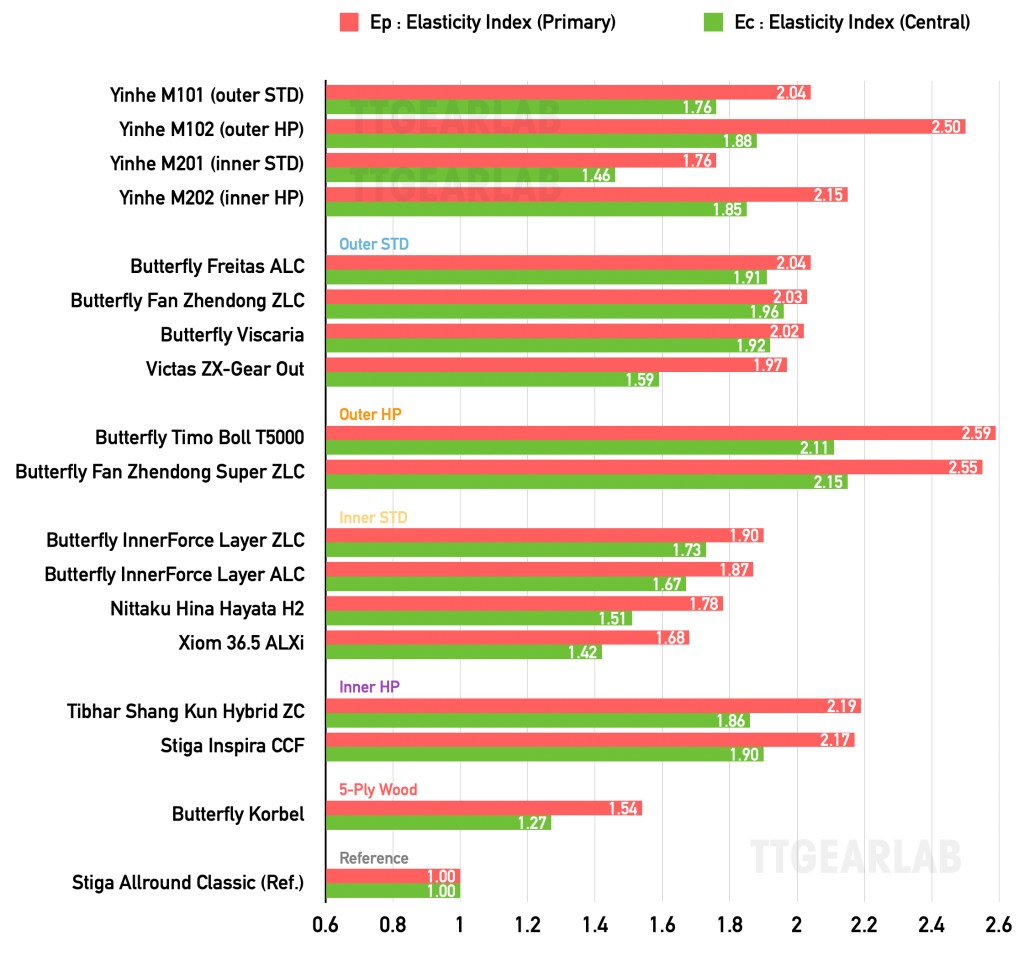
Fig.15 shows the comparison graph of Elasticity Indices.
Ep (Primary Elasticity Index) is directly concerned with the rebound speed of blade. Ec (Central Elasticity Index) is concerned with additional ‘kick’ when player hits ball very strongly.
‘Outer STD’ group corresponds to ‘M101’ which is the outer fiber blade of STANDARD type. The Ep’s of the blades in this group are around 2.0. But, it is noticeable that the Ec of ‘M101’ (= 1.76) is much lower than those of three Butterfly blades in this group. It means that there is more deflection at the center of ‘M101’ when compared with three standard outer-fiber blades of Butterfly. That characteristic provides higher ease of use for playing at close-to-table area and aiming at the rising of the ball. The only one blade in this group whose Ec is lower than that of ‘M101’ is Victas ‘ZX-Gear Out’. The Ec of ‘ZX-Gear Out’ is 1.59, and it is extremely low value as that of outer-fiber blade. It will make ‘ZX-Gear Out’ very easy to use at close-to-table area, but some players may think that the elasticity of ‘ZX-Gear Out’ is not sufficient. The Ec of ‘M101’ isn’t that extremely low.
‘Outer HP’ group corresponds to ‘M102’ which is the outer fiber blade of HIGH-POWER type. The Ep’s of the blades in this group is much higher than 2.0. ‘M102’ provides the primary elasticity comparable with ‘Timo Boll T5000’ and ‘Fan Zhendong Super ZLC’. But, The Ec of ‘M102’ is noticeably lower than those of two Butterfly blades in this group. We will be able to think that ‘M102’ holds the ball deeper than two Butterfly blades when the player hits the ball very strongly. It means that ‘M102’ is easier to use when the player aiming at rising, but some players will think that its ability of smash isn’t as good as that of two Butterfly blades in this group, because it gives relatively lower level of kick.
‘Inner STD’ group corresponds to ‘M201’ which is the inner fiber blade of STANDARD type. The Ep’s of the blades in this group is lower than 2.0. This group can be further divided into two – faster ones whose Ep’s are around 1.9 and slower ones whose Ep’s are 1.6~1.8. ‘M201’ can be categorized into slower ones in this group. And, the Ec of ‘M201’ is also close to those of two slower blades – ‘Hina Hayata H2’ and ‘36.5 ALXi’. The blades with moderate Ep and low Ec are especially good for very aggressive topspin, and ‘M201’ is one of that kind of blades.
‘Inner HP’ group corresponds to ‘M202’ which is the inner fiber blade of HIGH-POWER type. Differently from former three groups, the blades of this group show quite similar elasticity characteristics with ‘M202’. The Ep and the Ec of ‘M202’ are very close to those of ‘Shang Kun Hybrid ZC’ and ‘Inspira CCF’ despite the difference in top layer and artificial material. We have to examine the Vibration Indices to find the differences among those blades.
Finally we can compare ‘Korbal’ with four models of ‘Mars’ series. The important character of the Elasticity Indices of ‘Korbel’ is that its Ec is much lower than its Ep. And, we can find similar character from four models of ‘Mars’ series although there are significant differences in the level of elasticity. We will be able to consider the possibility that four models of ‘Mars’ series become the direct replacement of ‘Korbel’ for enhancing power.
Examining Ec/Ep is an easier way to understand the characteristics of blade concerned with elasticity. Fig.16 shows the relationship between Ec/Ep and Ep.
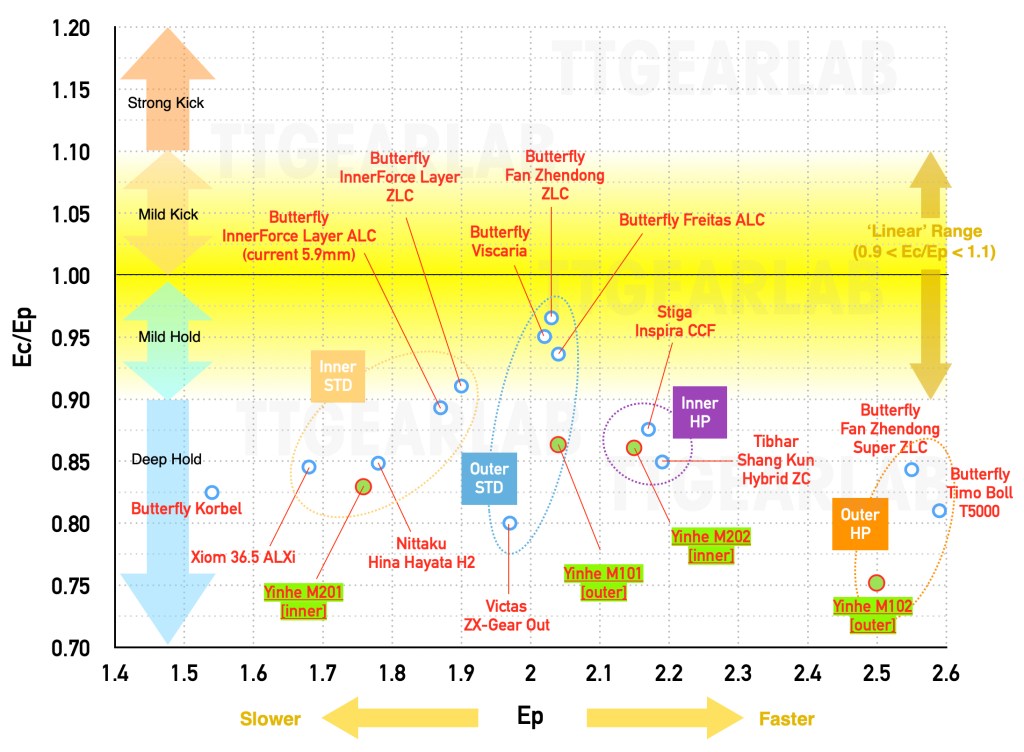
Ec/Ep expresses the ‘tendency’ of the elasticity of blade. By examining Ec/Ep and Ep at the same time, we can easily understand the behavior of blades.
On the graph, all blades in this comparison (except for reference blade whose Ec/Ep = 1.00) are in ‘Hold’ range (Ec/Ep < 1.0). And, from left to right, ‘Inner STD’ group, ‘Outer STD’ group, ‘Inner HP’ group, and ‘Outer HP’ group are placed. Please note that ‘Inner HP’ group lies to the right of ‘Outer STD’ group. It means that inner fiber blades can be more elastic than outer fiber blades depending on the blade construction, and there are three examples on the graph.
First, let’s observe ‘M101’ and ‘Outer STD’ group. Although there aren’t significant differences in Ep’s in this group, the blades are widely distributed up and down. Three Butterfly blades – ‘Fan Zhendong ZLC’, ‘Freitas ALC’ and ‘Viscaria’ (current version) – are in Mild Hold range. But, ‘M101’ is in Deep Hold range. It means that if the player hits the ball very strongly, ‘M101’ holds the ball more deeply than three Butterfly blades. Instead, three Butterfly blades will provide more kick than ‘M101’. If the player wants to play with powerful topspin while keeping the close-to-table area, ‘M101’ can be better than three Butterfly blades. But, if the player want to play also at mid-distance area, three Butterfly blades will be better than ‘M101’. Especially ‘Freitas ALC’ can be the direct competitor of ‘M101’ because it has same Limba top layer as ‘M101’. ‘ZX-Gear Out’ has also Limba top layer, and its Ec/Ep is even lower than that of ‘M101’. So ‘ZX-Gear Out’ will fit for more extreme style that always aims at rising, but the player will feel that ‘ZX-Gear Out’ doesn’t provide sufficient power for playing at mid-distance area. (It will be all right if the player plays with continuous high-loop at mid-distance area. But, it will not fit for power topspin from mid-distance area.)
Then let’s observe ‘M102’ and ‘Outer HP’ group. ‘Out HP’ group lies at the right end of the graph. ‘M102’ and two blades in this group – ‘Fan Zhendong Super ZLC’ and ‘Timo Boll T5000’ – are placed in ‘Deep Hold’ group. Although those blades shoot the ball with very high speed, those three will give the player the feeling of once catching the ball very deeply before releasing the ball. That kind of feeling may be strange in case the player attack with hard smash, but that characteristic gives very high level of safety and control of smash. ‘M102’ provides Deep Hold character which is more extreme than that of two Butterfly models, but it will not significantly affect the speed of ball because the primary elastic is very high. And, the player will be able to utilize the extreme hold character of ‘M102’ for playing more aggressively.
Next is the observation of ‘M201’ and ‘Inner STD’ group. ‘Inner STD’ group lies at the left end of the graph (if we don’t consider 5-ply wood blades). In the group, ‘M201’ lies to the lower left of two Butterfly models – ‘InnerForce Layer ALC (current version measured in 2023)’ and ‘Inner Force Layer ZLC’. So ‘M201’ is less elastic than two Butterfly blades and holds the ball deeper when the player hits the ball very strongly. Two Butterfly blades provide higher elasticity and more kick than ‘M201’. So we can understand that ‘M201’ aims at different goal than two Butterfly models, and probably it is more aggressive topspin that always aims at rising. On the contrary Butterfly models aim at more powerful play at more various areas of court. ‘Hina Hayata H2’ shows similar elasticity character as ‘M201’ despite of different top layer. It is located very close to ‘M201’ on the graph. And, although its primary elasticity is noticeably lower, ‘36.5 ALXi’ can be also compared with ‘M201’. ‘M201’, ‘Hina Hayata H2’ and ‘36.5 ALXi’ can be good solution in case the player wants to replace ‘Korbel’ with faster blade but wants to keep the hold level. (But, please consider the difference of top layer in case the player considers ‘M201’ as the replacement of ‘Korbel’. If the player doesn’t want to change the kind of top layer, ‘M201’ can’t be the solution.)
Finally we can observe ‘M202’ and ‘Inner HP’ group. Although there are significant differences in materials (of top layers and fibers), there isn’t much things to tell. ‘M202’, ‘Inspira CCF’ and ‘Shang Kun Hybrid ZC’ are placed very close together. So we have to look not at this elasticity characteristics but at vibration characteristics to find the differences. All three models are even more elastic than the blades of ‘Outer STD’ group, but give less kick than three Butterfly outer fiber blades Therefore the criteria for the selection between ‘Inner HP’ group and three Butterfly blades in ‘Outer STD’ group are clear. If the player requires higher base elasticity and deeper hold, the blades in ‘Inner HP’ group including ‘M202’ will be the solution. On the contrary, if the player requires lower base elasticity and more kick, three Butterfly STD outer fiber blades will be the solution. And, if the player thinks that the hold level of ‘Inner HP’ blades including ‘M202’ is good but wants to reduce the elasticity a bit, ‘M101’ can be the good solution although it is an outer-fiber blade.
Then next, let’s compare Vibration Indices.
Please click here to return to top (table of contents)
3-2. Vibration Indices
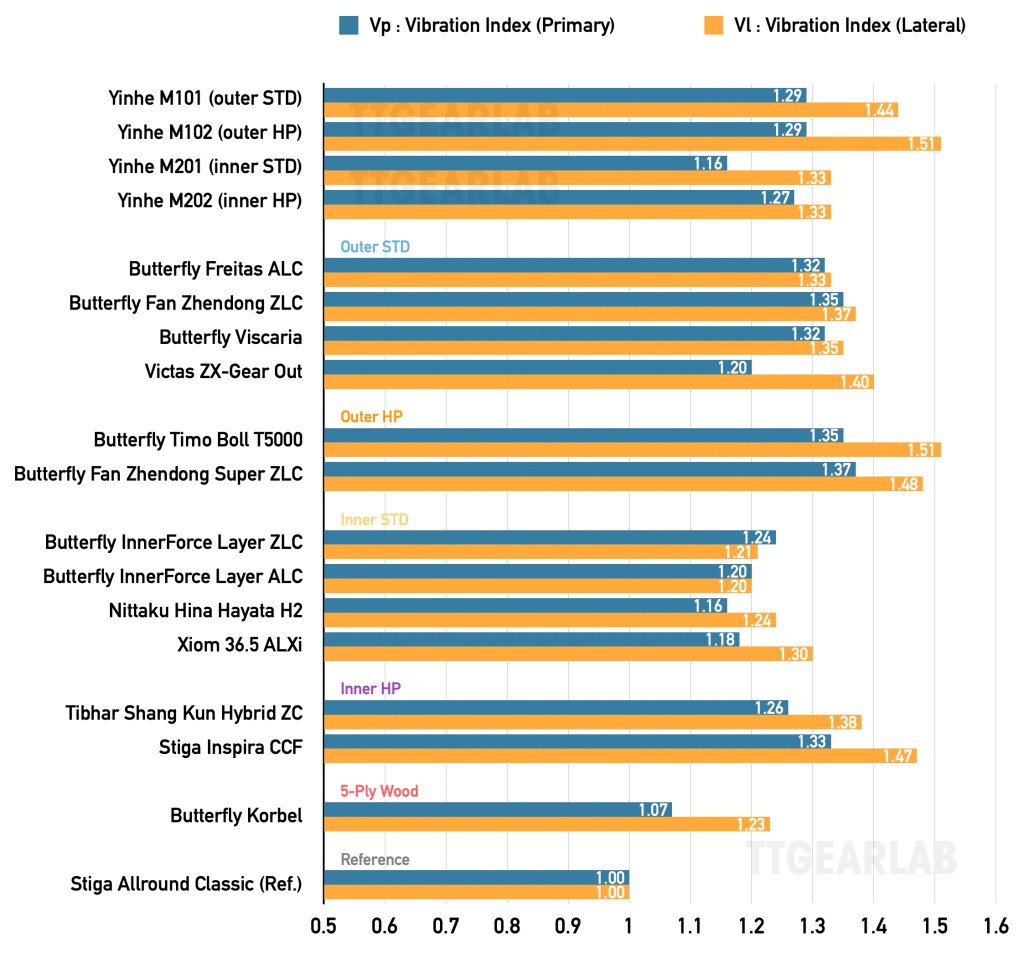
Fig.17 shows the comparison graph of Vibration Indices. Vibration Indices are concerned with feeling. Vp indicates primary feeling which is transferred to player’s palm. And, Vl is the feeling at the edge of the wing – the lower side of blade head. It is felt by player’s index finger or middle finger.
First comparison is between ‘M101’ and ‘Outer STD’ group. Except for ‘ZX-Gear Out’ the blades in ‘Outer STD’ group show a bit higher Vp’s than that of ‘M101’, but the difference isn’t significant. However, we can observe that the Vl of ‘M101’ is noticeably higher than those of three Butterfly blades in this group. It means that ‘M101’ gives much sharper feeling along the lateral direction – to index finger that contacts the wing of blade, when compared to ‘Freitas ALC’, ‘Fan Zhendong ZLC’ and ‘Viscaria’. And, both of the ‘Vp’ and the ‘Vl’ of ‘ZX-Gear Out’ are lower than those of ‘M101’. So the overall feeling of ‘ZX-Gear Out’ is softer than the feeling of ‘M101’.
Second comparison is between ‘M102’ and ‘Outer HP’ group. Before that comparison we can compare the indices of ‘M102’ with those of ‘M101’. Despite the higher elasticity, the Vp of ‘M102’ is identical to that of ‘M101’, and the Vl of ‘M102’ is just a bit higher than that of ‘M101’. So ‘M102’ isn’t noticeably harder or sharper than ‘M101’. And, the two blades in ‘Outer HP’ group – ‘Timo Boll T5000’ and ‘Fan Zhendong Super ZLC’ – show higher Vp’s than ‘M102’. Although the difference isn’t great, it is noticeable. So those two blades give harder primary feeling than ‘M102’. However, the Vl’s of those two are same as, or lower than that of ‘M102’. So there isn’t much difference of feeling in lateral direction. However, there will be noticeable difference if we consider the ratio – Vl/Vp. That is important because there are many cases that the relative feeling at index finger is more important than the absolute feeling.
Third comparison is between ‘M201’ and ‘Inner STD’ group. We can observe that the Vp’s of the blades in this group except for ‘Hina Hayata H2’ are higher than the ‘Vp’ of ‘M201’. But, the Vl’s of all models in this group are lower than the Vl of ‘M201’. Relatively lower Vp and relatively higher Vl can be considered as the character that distinguishes ‘M201’ from other standard inner fiber blades. ‘M201’ is basically softer, however it gives sharper feeling to the index finger of the player. The one that provide the closest character to ‘M201’ is ‘36.5 ALXi’. Although there is difference of top layer, the players may feel that ‘36.5 ALXi’ is quite close to ‘M201’.
Final comparison is between ‘M202’ and ‘Inner HP’ group. Before that comparison we can compare the indices of ‘M202’ with those of ‘M201’. And, we can observe that the Vl of ‘M202’ is same as that of ‘M201’, while the Vp of ‘M202’ is noticeably higher than the Vp of ‘M201’. To the index finger, ‘M201’ and ‘M202’ gives same level of feeling although there is big difference in primary feeling to the palm. The relatively low Vl also distinguishes ‘M202’ from the blades in ‘Inner HP’ group. The two models in this group – ‘Shang Kun Hybrid ZC’ and ‘Inspira CCF’ – show noticeably higher values of Vl. And, those two blades show bigger gaps between Vl and Vp when compared with ‘M202’.
Examining Vl/Vp is an easier way for the comparison of the tendency of feeling. Fig.18 shows the relationship between Vl/Vp and Vp for easier comparison.
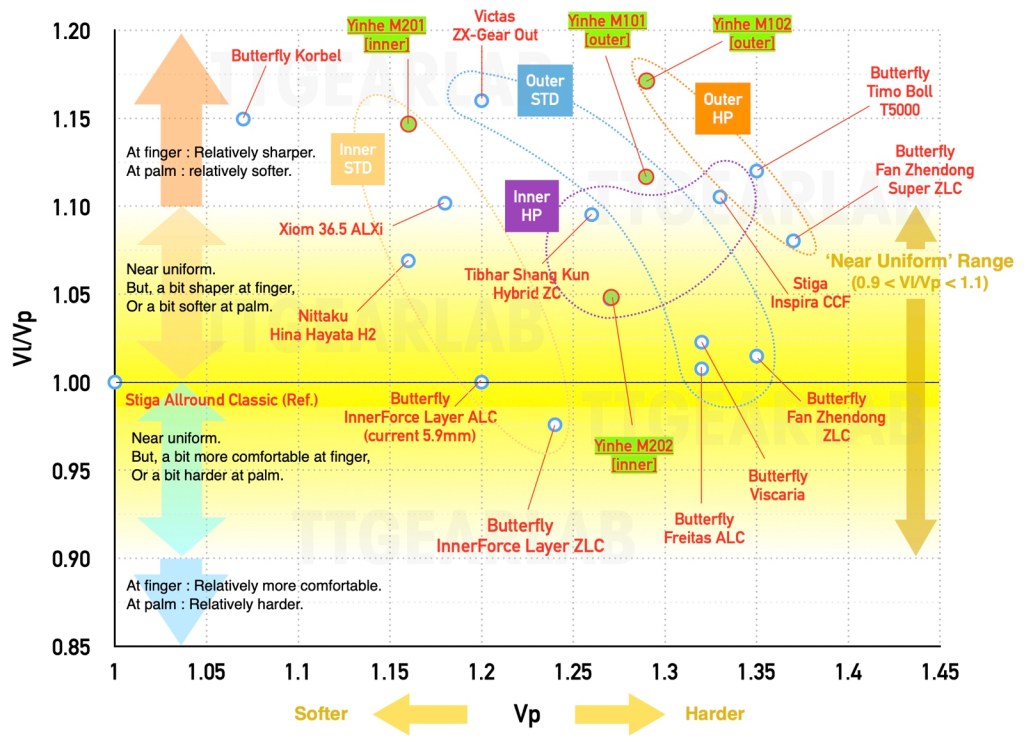
On the graph, most of blade in this comparison are placed in upper part of the graph – ‘Relatively sharper at finger’ range. And, one lies in lower part – ‘Relatively more comfortable at finger’, and two including reference blade are on uniform line (Vl/Vp = 1.0).
First, let’s observe ‘M101’ and ‘Outer STD’ group. We can see significant difference between ‘M101’ and three Butterfly standard outer fly models – ‘Freitas ALC’, ‘Fan Zhendong ZLC’ and ‘Viscaria’. ‘M101’ is located to the upper left of three Butterfly blades. It means that ‘M101’ is basically softer, but it gives sharper relative feeling to index finger. ‘M101’ is located in ‘relatively sharper at finger’ range (Vl/Vp > 1.0) while the three Butterfly blades in this group are located near the uniform line (Vl/Vp = 1.0). So ‘M101’ will give the player totally different experience from three Butterfly models. That difference will be important criteria especially when the player wants to select between two outer fiber blades with Limba top layer – ‘M101’ and ‘Freitas ALC’. And, if the player wants the outer fiber blade which is even softer than ‘M101’ and gives even sharper feeling to index finger, the solution will be ‘ZX-Gear Out’. On the graph, we can see that ‘ZX-Gear Out’ is far from any other outer fiber blade in this comparison, and instead it is close to ‘M201’ which is an inner fiber blade.
Then let’s observe ‘M102’ and ‘Outer HP’ group. We can see that ‘M102’ is located to the upper left of ‘Timo Boll T5000’ and ‘Fan Zhendong Super ZLC’. So ‘M102’ is much softer in primary feeling than two Butterfly blades, but it gives sharper relative feeling to the index finger. We can also see that its primary feeling is even softer than those of the three Butterfly blades in ‘Outer STD’ group. ‘M102’ will be very good solution for the players who requires very high elasticity of blade and sharp feeling at finger but doesn’t like hard primary feeling.
Next is the observation of ‘M201’ and ‘Inner STD’ group. ‘Inner STD’ group lies at the left end of the graph (if we don’t consider 5-ply wood blades). In the group, ‘M201’ lies to the upper left of all the blades in this group. So ‘M201’ is basically softer than the other standard inner-fiber blades in this comparison, but it gives the sharpest relative feeling to the index finger. Its Vl/Vp is on the same level as that of ‘Korbel’, and therefore it can be very good solution in case the player who have used ‘Korbel’ wants faster blade but doesn’t want to give up the sharp feeling. (If the player doesn’t like Koto top layer of ‘M201’, then ‘ZX-Gear Out’ can be the alternative.)
Finally we can observe ‘M202’ and ‘Inner HP’ group. ‘Inner HP’ group including ‘M202’ is overlapped with ‘Outer STD’ group on the graph. So ‘Inner HP’ group can be compared with ‘Outer STD’ group. (We have already observed that the blades in ‘Inner HP’ group are faster than the blades in ‘Outer STD’ group if we just consider primary elasticity.) Especially the Vp of ‘Inspira CCF’ is higher than those of many blades in ‘Outer STD’ group. But, the Vp’s of ‘M202’ and ‘Shang Kun Hybrid ZC’ aren’t that high. Although ‘M202’ and ‘Shang Kun Hybrid ZC’ are faster than the blades in ‘Outer STD’ group, those two provides sufficient softness as inner fiber blades. Further, the Vl/Vp of ‘M202’ is lower than those of ‘Shang Kun Hybrid ZC’ and ‘Inspira CCF’. It means that ‘M202’ gives more comfortable feeling at index finger when compared with two other inner fiber blades of high power type. But, the Vl/Vp of ‘M202’ is higher than three Butterfly blades in ‘Outer STD’ group. Therefore ‘M202’ can be good solution if the player who have used one of those three blades and requires a bit higher speed, deeper hold and sharper feeling at index finger.
Please click here to return to top (table of contents)
4. Summary
Yinhe ‘Mars’ series is the blade family whose artificial fiber is PLC (= Polyethylene Carbon) that is composite material of Polyethylene fiber and Carbon fiber. ‘Mars’ series consists of four models – two outer fiber models (= ‘M101’ and ‘M102’) and two inner fiber models (= ‘M201’ and ‘M202’). The characteristics of each of the four models are as follows :
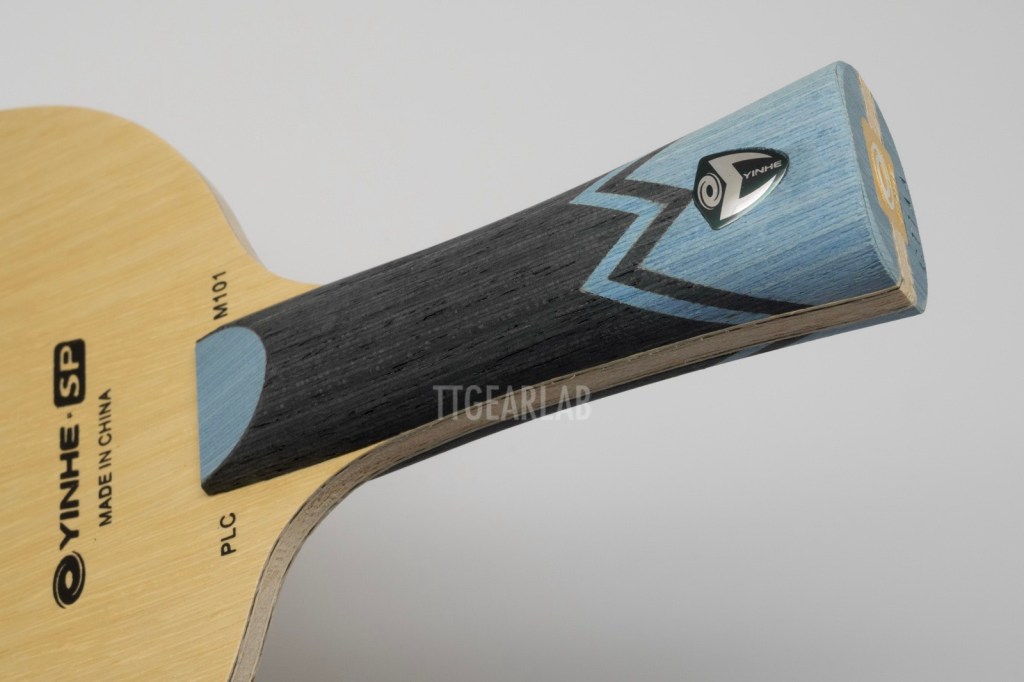
‘M101‘ is the outer PLC blade of standard type. Its primary elasticity is equivalent to the elasticity of some well-know outer fiber blades such as ‘Viscaria’ or ‘Freitas ALC’. But, when compared with those blades, ‘M101’ is softer, hugs ball deeper when the player hits the ball very strongly, and gives much sharper feeling to the index finger of the player. For that reason ‘M101’ is expected to be good solution for the player who is using outer fiber blade of standard elasticity and wants to get closer to the table and play with more aggressive topspin.
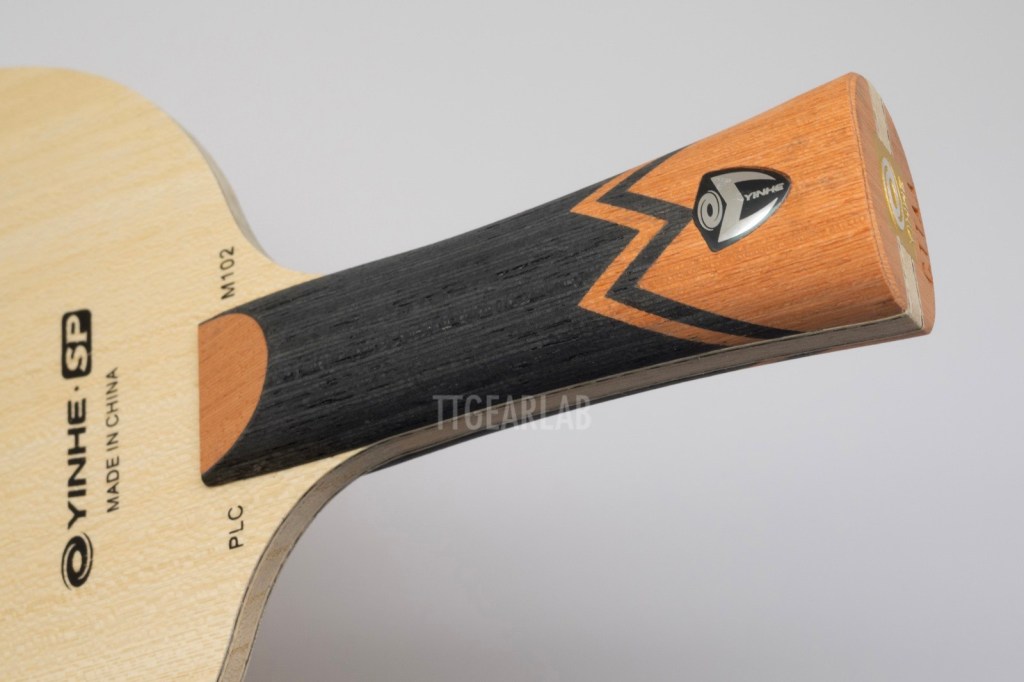
‘M102‘ is the outer PLC blade of high-power type. It provides top level of primary elasticity as an outer fiber blade. And, it hugs the ball deeper than some outer fiber blades of similar elasticity level. And, despite its high elasticity, ‘M102’ is much softer than many outer fiber blades including much slower ones. Further, it gives very sharp feeling at index finger. These characteristics of ‘M102’ help the player perform powerful topspin more stably and more aggressively. ‘M102’ is recommended for the players who lay emphasis on the power of topspin.
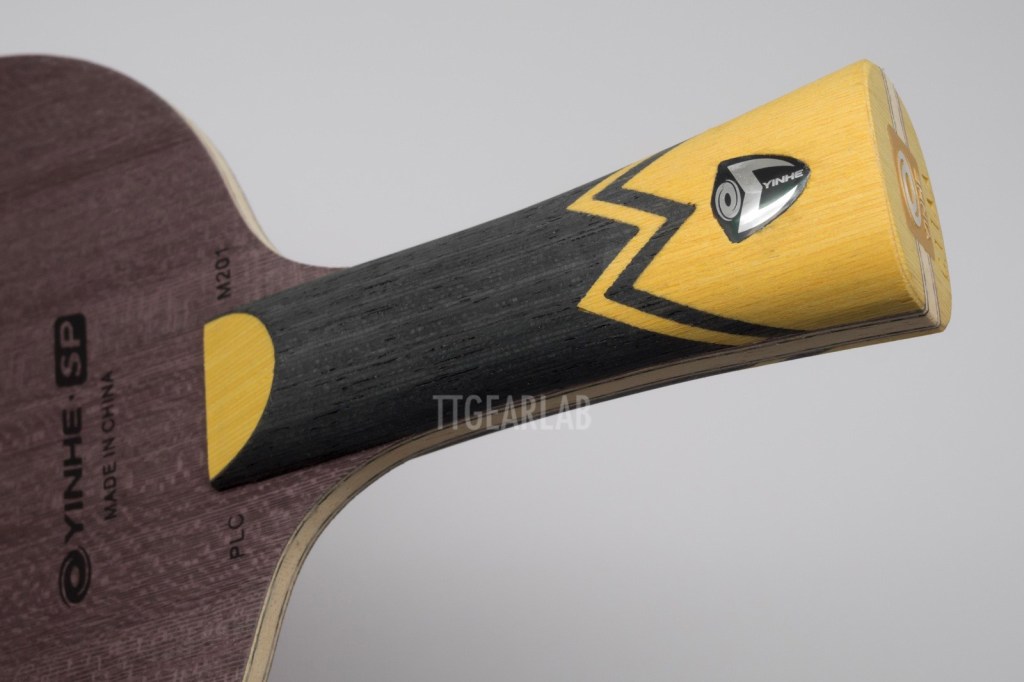
‘M201‘ is the inner PLC blade of standard type. But, it is slower and hugs ball deeper when compared with most of the other standard inner fiber blades. It also provides softer primary feeling at palm and much sharper relative feeling at index finger than most of standard inner fiber blades. These characteristics fit for extremely aggressive topspin that aims at rising of the ball.
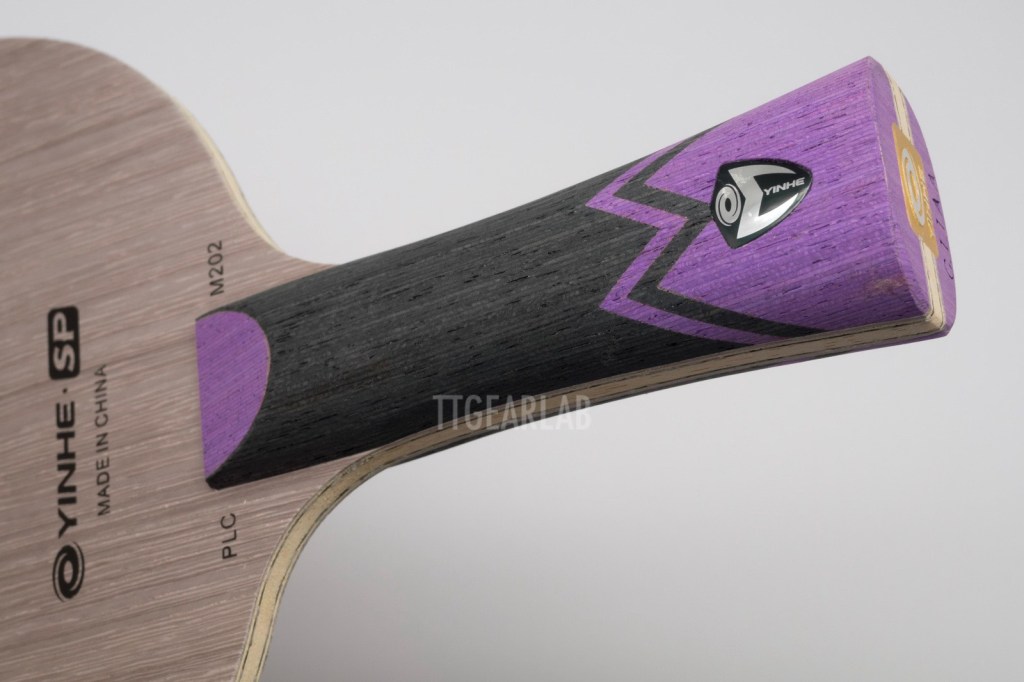
‘M202‘ is the inner PLC blade of high-power type. It is as fast as the other inner fiber blades of high-power type, and it means that ‘M202’ is even faster than many standard outer fiber blades. Despite of very high elasticity, the feeling of ‘M202’ is as soft as we can expect from inner fiber construction. Also the relative feeling transferred to index finger is more comfortable than those of high-power inner fiber blades under comparison. High speed and soft/comfortable feeling are the characteristics of ‘M202’, and those characteristics fits for ‘recent’ all-round style that lays emphasis not only on control but also on power. ‘M202’ is recommended for the player who wants to use a variety of technic but doesn’t want to give up the power of ball.
Please click here to return to top (table of contents)
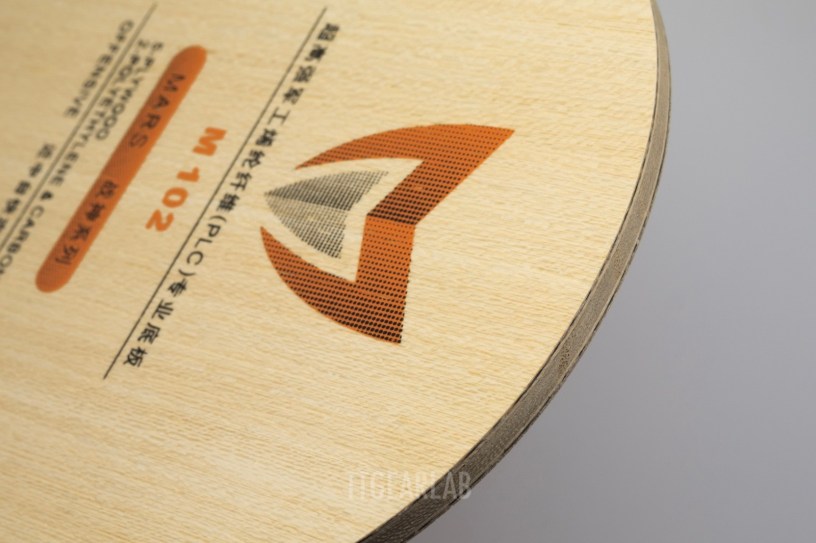
Great to see such detailed analyses of some less-expensive blades!
LikeLike
Thank you for comment. I will try to post many articles on less expensive models. 🙂
LikeLike
Looking forward to reading them as they come!
Two thoughts from this report:
(1) The Victas ZX-Gear Out numbers look interesting. Is it unusual for an ‘outer’ blade to have such a deep hold? My memory isn’t the best, but I don’t think I remember many of the other ‘outer’ blades you’ve tested showing similar results. I think one of the Carbonado series was similar, but I don’t remember others.
(2) Please could I ask you to explain what you mean by this sentence: “So ‘ZX-Gear Out’ will fit for more extreme style that always aims at rising.” By “rising” do you mean ‘contacting the ball before it reaches the peak of its bounce’?
Thanks again for the great work and your service to the TT community!
LikeLike
(1) I think that ZX-Gear Out is close to Carbonado 145 or 90. But, not totally similar.
(2) Yes. And, ‘Extreme’ means that the player ‘always’ aims at rising.
LikeLike
Yinhe pro 11s has 2 faces, one side inner plc and another side outer alc.
It will be great if you could review it
LikeLike
I will also deal with some Yinhe blades in near future. Currently I don’t have the sample of Pro 11S. But, it sounds interesting that its construction is asymmetric. It seems that I have to get its sample soon.
LikeLike
Can you consider to test Yinhe Mercury Y-13 fiber blade? It is very inexpensive blade with outer fiberglass construction. Speedwise I think it is close to Korbel (that opinion can be found over the web). The perfomance indecies coud clearify charcteristics of this blade.
LikeLike
I’m considering to get the samples of Y-13.
One problem is that I need many pcs. of that blade because the deviation of 5-ply wood blade is quite big.
LikeLiked by 1 person
Glad to hear this. They can be found quite cheap on aliexpress. I am not sure about quality of that blades. I just ordered two samples, 91 and 93 grams each, with protective plastic film.
LikeLike
In fact I don’t frequently use Ali Express. But, I will consider it. 🙂
(BTW, I’m not sure but probably I will be able to get the blades in different way.)
LikeLike
Hi, any plan for testing Yinhe Pro01 and Pro05, it is said Pro01 is similar to the stop prodution Butterfly Lingaoyuan alc.
LikeLike